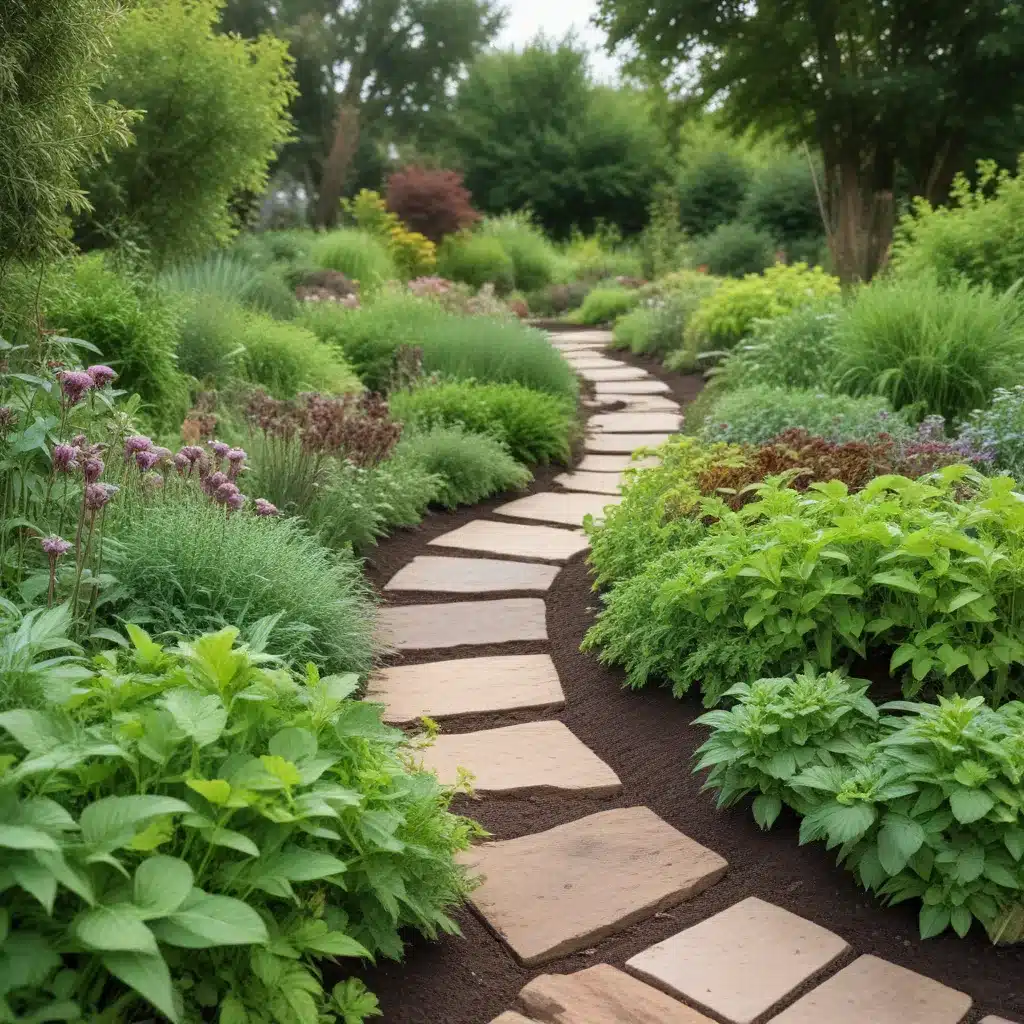
Elevating Edibles: Designing Attractive Edible Landscapes
As a farm educator at Crooked Pines, I’m excited to share my insights on creating edible landscapes – beautiful outdoor spaces that seamlessly integrate ornamental plants and productive edibles. Whether you have a sprawling acreage or a modest backyard, designing an edible landscape allows you to cultivate an abundance of delicious, nutrient-dense foods while enhancing the visual appeal and ecological function of your property.
Fundamental Principles
At the core of an edible landscape is the marriage of aesthetics and functionality. Rather than viewing the garden as a purely utilitarian space for growing food, we can embrace a holistic approach that elevates the senses and nourishes the spirit. By carefully selecting a diverse array of edible plants and arranging them in visually captivating ways, we can craft landscapes that are as beautiful as they are bountiful.
Equally important is the principle of sustainability. An edible landscape should be designed to thrive with minimal input, relying on natural cycles, beneficial relationships, and regenerative practices. This not only reduces your ecological footprint but also ensures the long-term viability and resilience of your garden.
Plant Selection
The key to a successful edible landscape lies in the careful selection of plant material. Look beyond the traditional separation of ornamentals and edibles, and instead, seek out versatile, dual-purpose species that deliver both visual appeal and productivity.
Ornamental Edibles: Plants like artichokes, Swiss chard, and purple kale offer striking foliage and vibrant hues, while also providing nutritious harvests. Blueberries, currants, and raspberries can be incorporated as lush, textural shrubs that reward you with bountiful fruit. Herbs such as rosemary, lavender, and thyme not only infuse the garden with their captivating aromas but also serve as culinary staples.
Productive Perennials: Perennial food crops like asparagus, rhubarb, and Jerusalem artichokes bring a sense of permanence and reliability to the landscape, while their architectural forms and foliage lend visual interest throughout the seasons. Fruit trees and nut trees, such as apples, pears, and hazelnuts, can be strategically placed to provide shade, framing, and bountiful harvests year after year.
Annual Culinary Herbs: Don’t forget the versatility of annual herbs like basil, cilantro, and parsley. These flavorful plants can be woven throughout the landscape, adding pops of color, texture, and aroma while serving as dynamic companions to your edible crops.
Companion Planting
One of the hallmarks of an edible landscape is the intentional pairing of plants to foster beneficial interactions. By thoughtfully combining edibles with companion plants, you can enhance the overall health, productivity, and resilience of your garden.
Consider companion planting strategies that deter pests, attract pollinators, and improve soil fertility. For example, planting marigolds alongside your tomatoes can help repel harmful insects, while sweet alyssum attracts beneficial predatory insects that prey on garden pests. Incorporating nitrogen-fixing legumes, such as clover or vetch, can improve soil health and provide nutrient-rich mulch for your vegetable beds.
Beyond the practical advantages, companion planting can also create visually stunning arrangements. Pairing vibrant edible flowers like nasturtiums or borage with lush foliage plants can result in captivating color combinations and textures that delight the senses.
Spatial Arrangement
Thoughtful zoning and layout are essential for transforming your edible landscape into a harmonious and functional space. Begin by identifying distinct areas for different purposes, such as a kitchen garden near the house, a foraging zone for children, or a shaded retreat for relaxation.
Incorporate focal points and accents to draw the eye and create a sense of drama. A sculptural fruit tree, a flowering vine-covered arbor, or a bubbling water feature can serve as visual anchors, complemented by a tapestry of surrounding plants.
Carefully consider circulation and access, ensuring that paths and walkways allow for easy navigation and harvesting. Layering plants of varying heights, textures, and growth habits can create a visually dynamic and multifunctional space, where you can move through the landscape and discover new delights at every turn.
Seasonal Transitions
An edible landscape should be designed to maintain year-round visual interest and seasonal harvests. Carefully select a diverse range of plants that offer a succession of blooms, foliage changes, and edible yields throughout the seasons.
In spring, bulbs, flowering perennials, and early-bearing crops like salad greens and radishes can set the stage for a vibrant awakening. As summer arrives, tomatoes, peppers, and summer squash take center stage, accompanied by the vibrant hues of edible flowers. As autumn approaches, leafy greens, root vegetables, and late-season berries provide a rich, warm-toned palette, while evergreen herbs and structural plants maintain a sense of continuity.
By carefully planning for these seasonal transitions, you can ensure that your edible landscape remains visually captivating and productive year-round, delighting your senses and nourishing your body.
Soil and Cultivation
The foundation of a thriving edible landscape lies in the health and vitality of the soil. Prioritize building nutrient-rich, organic-matter-rich soil through the incorporation of compost, aged manure, and other natural amendments. This not only supports the robust growth of your edibles but also enhances the water-holding capacity and nutrient cycling of the ecosystem.
Embrace diverse cultivation techniques to accommodate the varying needs of your plants. Raised beds and container gardens can provide optimal drainage and soil conditions for crops that thrive in well-aerated, nutrient-dense environments. Integrated pest management strategies, such as the use of beneficial insects and organic pest control methods, can help maintain the delicate balance of your edible landscape without relying on harsh chemicals.
By approaching your edible landscape with a holistic, sustainable mindset, you can create a vibrant, nourishing oasis that seamlessly blends beauty, function, and ecological harmony. Whether you’re starting from scratch or transforming an existing garden, the principles outlined here will guide you in elevating your edibles and cultivating a true Garden Wonderland at Crooked Pines Farm.


